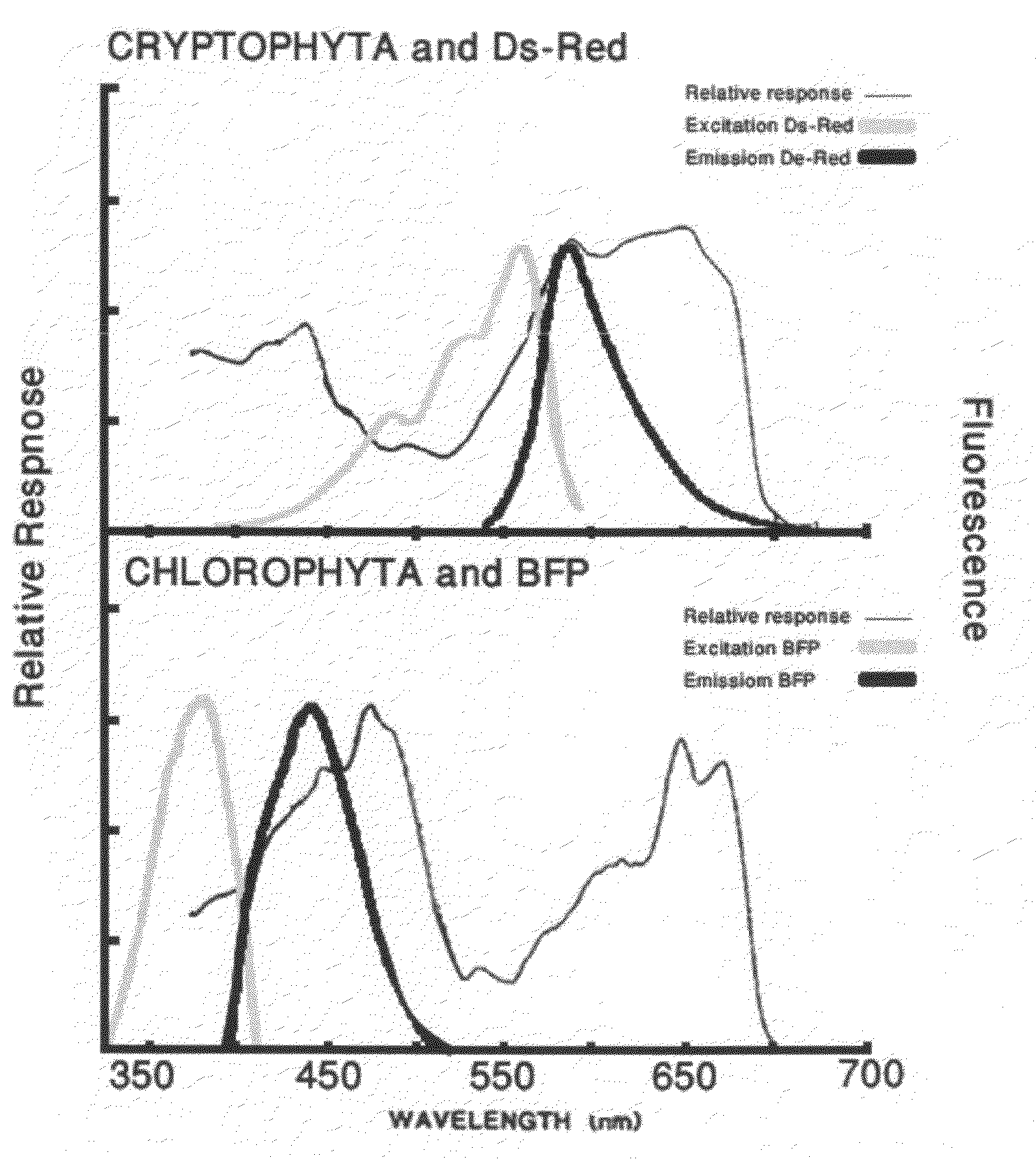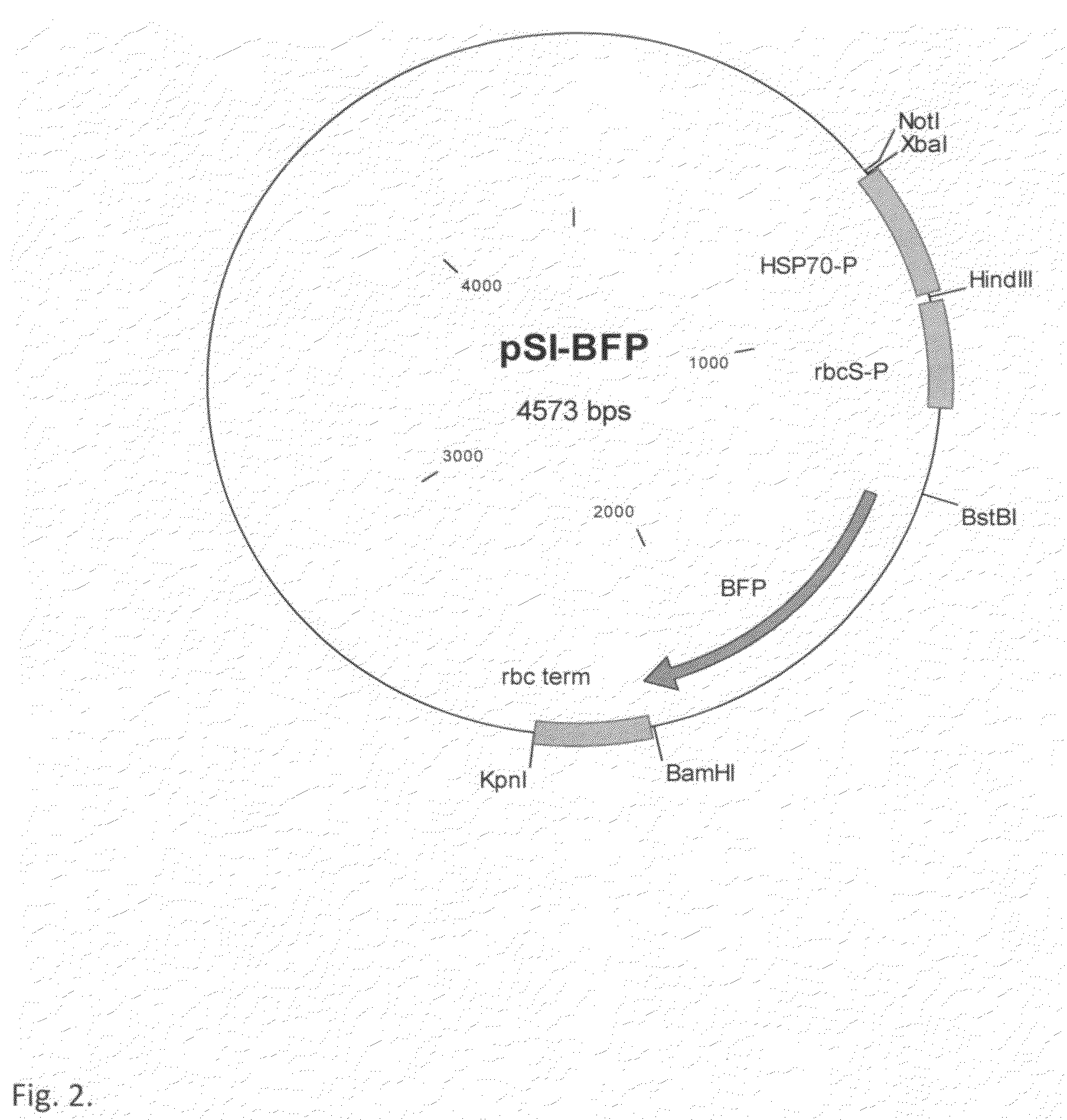Use of fluorescent protein in cyanobacteria and algae for improving photosynthesis and preventing cell damage
a technology of fluorescent protein and cyanobacteria, which is applied in the field of plant molecular biology, can solve the problems of reducing biomass yield, dispersing energy, cell damage, etc., and achieves the effects of enhancing photosynthesis, preventing cell damage, and increasing stability
- Summary
- Abstract
- Description
- Claims
- Application Information
AI Technical Summary
Benefits of technology
Problems solved by technology
Method used
Image
Examples
example 1
Generation of Eukaryotic Algae Cells Expressing BFP-Azurite
[0049]The BFP-azurite sequence (Mena et al., 2006) was artificially synthesized using the published sequence (SEQ ID NO: 1) with modifications according to the codon usage of P. tricornutum (BFP-Pt) (SEQ ID NO: 2) and the green algae C. reinhardtii (BFP-Cr) (SEQ ID NO: 3) and with the addition of BstBI and BamHI restriction sites at its ends. The gene was cloned into pGEM-T vector (Promega, Madison, USA) and then ligated into the BstBI / BamHI restriction sites of pSI103 (Sizova et al., 2001) replacing the aphVIII selectable marker gene, generating the plasmid pSI-BFP. In this plasmid the BFP-azurite gene is under the control of the Hsp70A / RbcS2 promoter and 3′ RbcS2 terminator.
[0050]Parental strain C. reinhardtii CC-425 was co-transformed with the pSI-BFP-Pt plasmid and linearized plasmid pJD67, containing the structural gene (ARG7) of the argininosuccinate lyase to complement the arg2 locus (Davies et al. 1994, 1996). C. rei...
example 2
Generation of Synechococcus PCC7002 Expressing the BFP-Azurite Gene Under the Control of the Cyanobacterial rbcLS Promoter
[0053]The BFP-azurite sequence (Mena et al., 2006) is artificially synthesized to enhance stability using the published sequence (SEQ ID NO: 1), but with modifications according to the preferred codon usage of Synechococcus PCC7002 (SEQ ID NO: 7) and with the addition of BamHI restriction sites at both ends. The gene is cloned into pGEM-T vector (Promega, Madison, USA) and then transferred into the BamHI site of pCB4 plasmid (Deng and Coleman, 1999) downstream to the Synechococcus PCC 7002 rbcLS promoter (SEQ ID NO:8) and upstream to rbcLS terminator.
[0054]Likewise, similar constructs, made based on codon usage of other cyanobacterial species are generated and transformed into these species.
example 3
Generation of Eukaryotic Algae Cells Expressing DsRed
[0055]The DsRed gene is artificially synthesized using the published sequence (accession number BAE53441; SEQ ID NO: 9) with modifications according to the codon usage of the green algae C. reinhardtii (SEQ ID NO: 10) and with the addition of BstBI and BamHI restriction sites at its ends. The gene is cloned into pGEM-T vector (Promega, Madison, USA) and then ligated into the BstBI / BamHI restriction sites of pSI103 (Sizova et al., 2001) replacing the aphVIII selectable marker gene, generating the plasmid pSI-DsRed. In this plasmid the DsRed gene is under the control of the Hsp70A / RbcS2 promoter (SEQ ID NO:11) and 3′ RbcS2 terminator. The gene product fluoresces green light to red wavelengths.
[0056]The pSI-DsRed plasmid is co-transformed with pSI103 containing the paromomycin resistance gene to C. reinhardtii CW15 (CC-400) and with pSI-PDS plasmid containing the pds gene (conferring resistance to the phytoene desaturase-inhibiting h...
PUM
| Property | Measurement | Unit |
|---|---|---|
| wavelength | aaaaa | aaaaa |
| diameter | aaaaa | aaaaa |
| diameter | aaaaa | aaaaa |
Abstract
Description
Claims
Application Information
 Login to View More
Login to View More - R&D
- Intellectual Property
- Life Sciences
- Materials
- Tech Scout
- Unparalleled Data Quality
- Higher Quality Content
- 60% Fewer Hallucinations
Browse by: Latest US Patents, China's latest patents, Technical Efficacy Thesaurus, Application Domain, Technology Topic, Popular Technical Reports.
© 2025 PatSnap. All rights reserved.Legal|Privacy policy|Modern Slavery Act Transparency Statement|Sitemap|About US| Contact US: help@patsnap.com



